Hop on the wagon as we run through Granaries, Lumber Mills, Universities and more.
In the previous installation of the Economy series1 we covered Fish and Rare Resources. This time we’re circling back to an extension of basic resources – their enhancement or amplifier buildings.2
To varying degrees, all of the six basic resources have a building available which increases the effective gather rate of that particular resource.
Food, Timber, and Metal have the most straightforward enhancement buildings. The Granary, Lumber Mill, and Smelter respectively are all tied to the economic radius of the city which they’re built in. They will only amplify the output of Farms, Woodcutter’s Camps, and Mines (respectively) built within the same City’s economic radius (although Granaries can also apply their effects to the Food gather rate of Fishermen if you have the corresponding research completed).
The increased gather rate applied by each of the three structures can be further boosted via research at the respective building, which will then apply to all buildings of that type. For example, if you research an upgrade at one Granary, it will then permanently increase the effect of all Granaries (both present and future).
Oil works slightly differently, since Refineries increase Oil production by a fixed amount globally. Temples and Universities are a little different again, as you’ll soon see.
| Structure | Applies to | Effect range | Baseline gather rate increase (no upgrades) |
|---|---|---|---|
| Granary | Farms Fishermen (with research) | Local (that City only)^ | Food gather rate +20% |
| Lumber Mill | Woodcutter's Camps | Local (that City only) | Timber gather rate +20% |
| Smelter | Mines | Local (that City only) | Metal gather rate +50% |
| Refinery | ALL Oil income | Global | Oil gather rate +33%, stacking additively |
| Temple | Taxation income* | Global | N/A (requires research to have effect on Wealth) |
| University | Universities** | Global | Knowledge gather rate +10 (flat increase)*** |
^ The effect on Fishermen is global, but doesn’t apply until you do research at the Granary.
* Which requires research – a Temple without research will not generate any income beyond its completion bonus.
** Universities are both the basic structure and the enhancement structure for themselves, so when you build one, you automatically gain the effect at that University of whatever amplifying research you’ve previously completed.
*** Each University provides a flat +10 Knowledge – this part doesn’t get increased with research, only Scholar-based Knowledge does.
Most of the enhancement buildings have research increasing their “amplification rate” i.e. increasing their effect on the gather rate of their respective resource. Most of these structures also have a second tree of research which will affect a vaguely thematically-related thing (such as construction speed and building HP research at the Lumber Mill).
Granary
A Granary amplifies the output of all Farms in the same City’s economic radius that the Granary is built in. Only one Granary can be built per City, and it must be placed within the City’s economic radius. Each Granary will only affect a single City’s Farms, even if the Granary is within the economic radius of more than one City.
With no research upgrades, a Granary increases Food output from Farms by 20%, which would be the same increase as putting a hypothetical sixth farm in the city if it already has five. With fully-completed research this increase maxes out at 200%, literally 10 times the increase.
In order to construct a Granary, you need Classical Age (II) and Science 2. It has a base cost of 60 Timber and 40 Wealth, with a Timber-only ramping cost of 40.
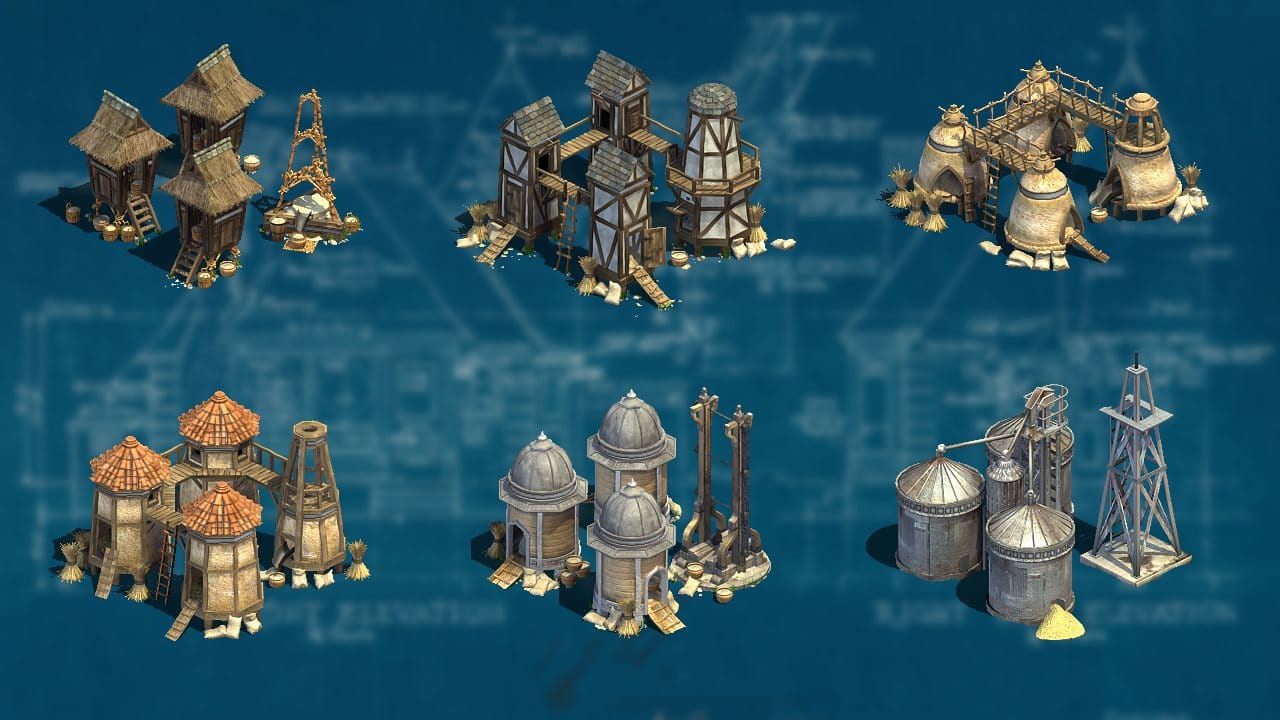
There are two research trees available at Granaries, and they require certain levels of library tech to be available for research.
- Agronomics increases the effect of the Granary’s amplification on Farms, and additionally now globally applies the same bonus to the Food gather rate to Fishermen.3 Before completing any Agronomics research, Granaries have no effect on Fishermen.
- Healthcare reduces the production time of foot and mounted units, increases their Line of Sight, and increases the rate at which garrisoned units heal.
| Agronomics Technology | Cost | Requires | Effects |
|---|---|---|---|
| None | - | Science 2 | Granaries increase Food output of affected Farms by 20% |
| Agriculture | 150 Timber, 150 Metal | Science 3 | Granaries increase Food output of affected Farms by 50% Fishermen gather +50% Food |
| Crop Rotation | 250 Timber, 250 Metal | Science 4 | Granaries increase Food output of affected Farms by 100% Fishermen gather +100% Food |
| Food Industry | 450 Timber, 450 Metal | Science 6 | Granaries increase Food output of affected Farms by 200% Fishermen gather +200% Food |
| Healthcare Technology | Cost | Requires | Effects |
|---|---|---|---|
| None | - | - | Garrisoned units heal 1 HP every 1.33 seconds* |
| Herbal Lore | 80 Food, 80 Wealth | Classical Age (II), Science 2 | Foot and mounted units' production time -10% and LOS +2 Garrisoned units heal 1 HP every second* |
| Medicine | 180 Food, 180 Wealth | Gunpowder Age (IV), Science 3 | Foot and mounted units' production time -20% and LOS +4 Garrisoned units heal 1 HP every 0.67 seconds* |
| Pharmaceuticals | 350 Food, 350 Wealth | Industrial Age (VI), Science 5 | Foot and mounted units' production time -30% and LOS +6 Garrisoned units heal 1 HP every 0.33 seconds* |
* These numbers are for garrisoned land units; garrisoned naval units heal somewhat faster, and garrisoned aircraft generally heal somewhat slower.
Although Cities produce 10 Food, Granaries do not have any effect on this number – with or without Granary research completed.
Granaries don’t increase the Food income from rare resources other than Fish, and they also don’t increase the Food income from Cities themselves. With Agronomics researched Granaries do affect the Food gather rate of Fish, but this applies only to Food – Wealth income from Fish is not affected by Granaries at all, with or without research.

Lumber Mill
A Lumber Mill amplifies the output of all Woodcutter’s Camps within the same City’s economic radius that the Lumber Mill is built in. As with Granaries, only a single Lumber Mill is allowed per City, and it has be placed within a City’s economic radius. Each Lumber Mill can only boost the Woodcutter’s Camps of a single City even if constructed within the economic radius of multiple Cities.
With no research upgrades, a Lumber Mill increases the Timber produced by Woodcutter’s Camps by 20%. With fully-completed research this increase maxes out at 200% – this mirrors the Granary on both counts.
In order to construct a Lumber Mill, you need Classical Age (II) and Science 2. It has a base cost of 60 Food and 40 Metal to construct, with a Metal-only ramping cost of 40.
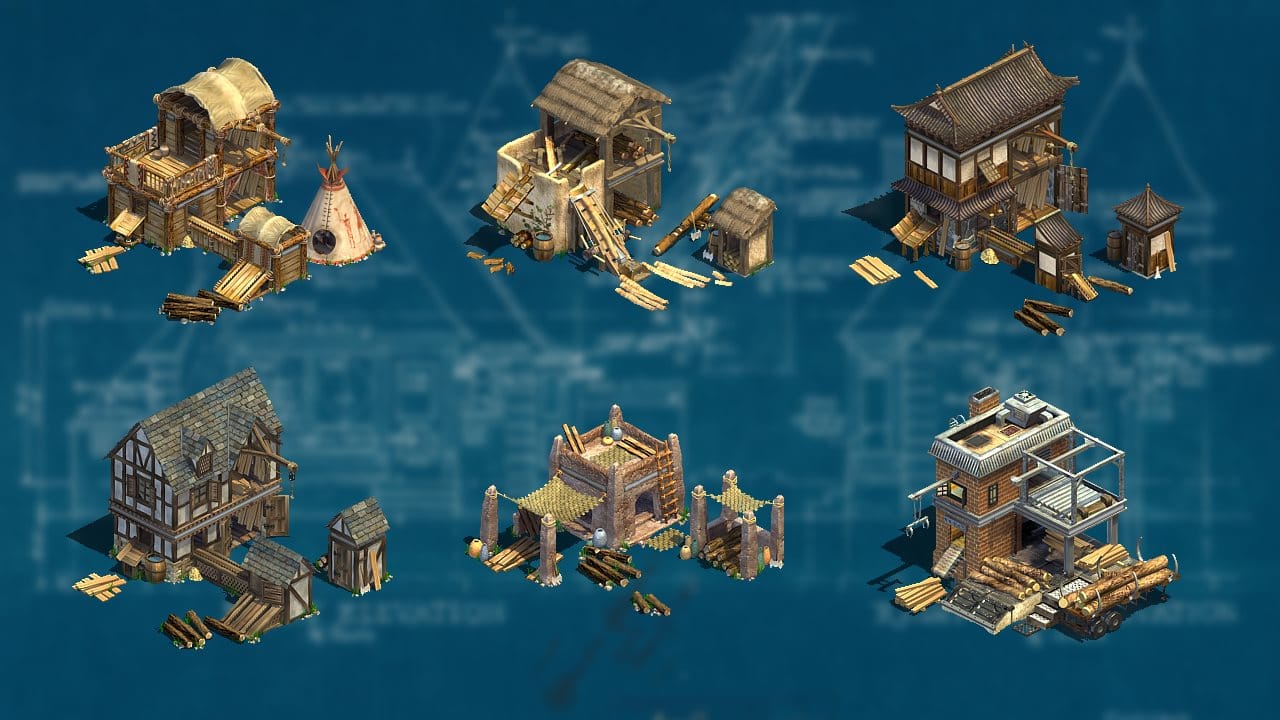
There are two research trees available at Lumber Mills, and they require certain levels of library tech to be available for research.
- Woodworking increases the amount which Lumber Mills amplify the output of Woodcutter’s Camps.
- Construction decreases building construction time and increases the maximum HP of buildings.
| Woodworking Technology | Cost | Requires | Effects |
|---|---|---|---|
| None | - | Science 2 | Lumber Mills increase Timber output of affected Woodcutter's Camps by 20% |
| Carpentry | 150 Food, 150 Metal | Science 3 | Lumber Mills increase Timber output of affected Woodcutter's Camps by 50% |
| Logging Industry | 250 Food, 250 Metal | Science 4 | Lumber Mills increase Timber output of affected Woodcutter's Camps by 100% |
| Papermill | 450 Food, 450 Metal | Science 6 | Lumber Mills increase Timber output of affected Woodcutter's Camps by 200% |
| Construction Technology | Cost | Requires | Effects |
|---|---|---|---|
| None | - | - | None |
| Construction | 80 Timber, 80 Wealth | Classical Age (II), Science 2 | Buildings are constructed 10% faster and have +10% HP |
| Architecture | 150 Timber, 150 Wealth | Gunpowder Age (IV), Science 3 | Buildings are constructed 20% faster and have +20% HP |
| Pharmaceuticals | 350 Timber, 350 Wealth | Industrial Age (VI), Science 5 | Buildings are constructed 30% faster and have +30% HP |
As with Granaries, Lumber Mills don’t have any impact on the Timber produced by the City itself.
Interestingly, Architecture (the Lumber Mill’s second B-Tech) is cheaper than Medicine (the second Granary’s B-Tech) – despite the fact their the respective first and third B-Techs are the same price.
Smelter
A Smelter amplifies the output of all Mines in the same City’s economic radius that the Smelter is built in. Smelters can only be built in a City’s economic radius (with the usual max one per City), and will only affect a single City’s Mines, even if the Smelter is within the economic radius of more than one City.
Unlike Granaries and Lumber Mills, a Smelter with no research upgrades increases Metal produced by Mines by 50% – which the former structures can only attain with additional first-level research. With fully-completed research the Smelter’s maximum boost is 200%, just like the Granary and Lumber Mill.
In order to construct a Smelter, you need Classical Age (II) and Science 3 (one Science level higher than a Granary or Lumber Mill). It costs 70 Timber and 50 Wealth to construct, with a Timber-only ramping cost of 40.
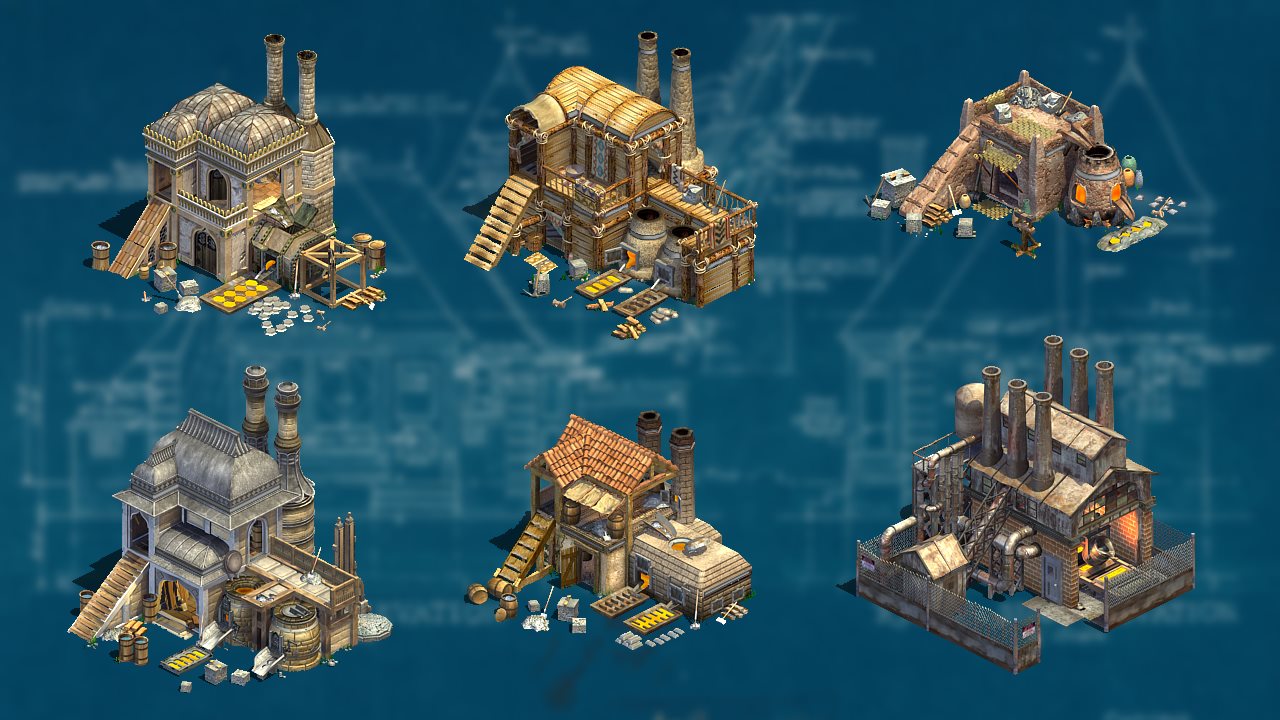
Like its Food and Timber based cousins, the Smelter has two research trees available, and they require certain levels of library tech to be available for research.
- Metallurgy increases the amount which Smelters amplify the output of Mines.
- Supply has a variety of effects, but is likely best known for reducing attrition damage taken in enemy territory.
I hope you’re ready for one of the messiest tables you’ve ever seen.
| Metallurgy Technology | Cost | Requires | Effects |
|---|---|---|---|
| None | - | Science 3 | Smelters increase Metal output of affected Mines by 50% |
| Metal Alloys | 250 Food, 250 Timber | Science 4 | Smelters increase Metal output of affected Mines by 100% |
| Cold Casting | 350 Food, 350 Timber | Science 5 | Smelters increase Metal output of affected Mines by 150% |
| Steel | 450 Food, 450 Timber | Science 6 | Smelters increase Metal output of affected Mines by 200% |
| Supply Technology | Cost | Requires | Effects |
|---|---|---|---|
| None | - | - | - |
| Forage | 80 Metal, 80 Wealth | Medieval Age (III), Science 2 | - Ships, artillery, and vehicles are created 10% faster* - Supply Wagons and Totalitarian (red) Patriots gain 20 HP, 2 range/radius, and 6 speed**^ - Unsupplied units in enemy territory receive 25% less attrition damage and are not affected by attrition damage if not moving or attacking*** - Totalitarian (red) Patriots have 1000 more Craft**** |
| Supply | 160 Metal, 160 Wealth | Enlightenment Age (V), Science 4 | - Ships, artillery, and vehicles are created 20% faster* - Supply Wagons and Totalitarian (red) Patriots gain 40 HP, 4 range/radius, and 12 speed**^ - Unsupplied Units in enemy territory receive 50% less attrition damage and are (still) not affected by attrition damage if not moving or attacking*** - Totalitarian (red) Patriots have 2000 more Craft**** |
| Logistics | 240 Metal, 240 Wealth | Modern Age (VII), Science 6 | - Ships, artillery, and vehicles are created 30% faster* - Supply Wagons and Totalitarian (red) Patriots gain 60 HP, 6 range/radius, and 18 speed**^ - Unsupplied Units in enemy territory receive 75% less attrition damage and are (still) not affected by attrition damage if not moving or attacking*** - Totalitarian (red) Patriots have 3000 more Craft**** |
The second table gets bullet points because there’s just so many things to cover.
* The number is not specified, but a quick test for both a ship and a catapult showed a 10% difference for the first research level, so I’ve assumed that the tech simply mirrors the 10% per level that the Granary B-Tech uses and doesn’t have any unexpected exceptions or outliers.
** The speed number is based on my own testing, since I was unable to find an exact number online or even in the game’s xml files.4
^ This might actually make the red Patriots the fastest ground units in the game when upgraded with all the Supply tech. Their base movement speed is already very fast at 42 — faster than all Light Cavalry by 1 — but all three techs would give them another +18 for a total of 60(!) movement speed. However, if you switch to a green government, the bonus to your Patriot is lost until you return to a red government (i.e. the bonus will only apply to current red-government Patriots, regardless of what that unit used to be).
*** This applies regardless of the enemy attrition level – so long as the unit would otherwise be capable of being supplied. For example, Militia can’t be supplied and are likewise unaffected by this attrition immunity, but if you convert them back to Citizens then they can happily camp out inside enemy territory again.
**** This isn’t listed as a benefit anywhere in the game, but is one nonetheless. If you switch to a green government, the bonus to your Patriot is lost until you return to a red government (i.e. the bonus will only apply to current red-government Patriots, regardless of what that unit used to be).
As mentioned pre-tables, although a Smelter starts out with a 50% amplification effect, it still only ends at 200% with all research completed. This means the final A-Tech upgrade for the Smelter seems — relatively speaking — poor value compared to final A-Tech of the Granary and Lumber Mill. There’s probably minimal gameplay implications from this discrepancy, but it’s interesting to note nonetheless.
In another seemingly arbitrary deviation, the third level B-Tech upgrade is also comparatively cheap. This means that it’s cheaper to get three anti-attrition upgrades than it is to get three attrition upgrades. However, since there’s a fourth attrition level at the equivalent tech level (Modern Age), it’s not a particularly useful piece of trivia either.
An interesting discovery for me was confirming from an unverified source5 the undocumented effect that the Smelter B-Tech has on the craft of Totalitarian (red) Patriots. With a couple of upgrades, you can use your single Patriot to simultaneously provide Ambush, Forced March, and Decoys to an army – pretty crazy.
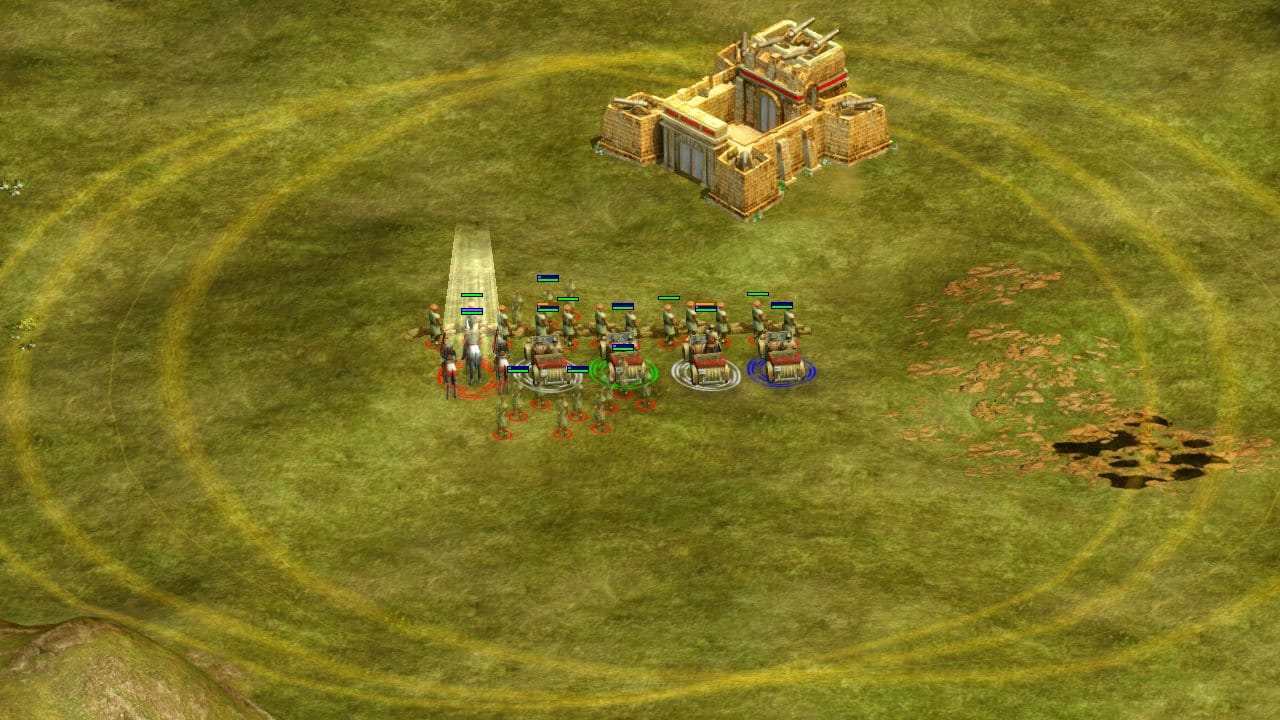
Refinery
If the Smelter was where the wheels of the “standard enhancement building template” wagon started to get a little loose, the Refinery is where the wheels start to come off of it outright.
Firstly, the Refinery applies globally to all oil production. If you build a Refinery on one side of the map, it will increase the Oil gather rate of an Oil Well — or Titanium Merchant — on the other side of the map.
The increase is a flat 33% per Refinery, stacking additively (for example, three Refineries will increase production by 99%). You still have to build it within a City’s economic radius, and there’s still the usual one-per-City limit.
The library tech needed to construct a Refinery is Industrial Age (VI) and Science 6.6 It has a base cost of 100 Timber and 50 Metal, with a ramping cost of 15 Timber and 15 Metal. This is coincidentally the same base cost and ramping cost of Oil Wells (but not Oil Platforms, the sea-based variant which costs slightly more to build).
There are no technologies available for research at the Refinery, so you’ll have to resort to just building more of them if you want to increase the amplifying effect.
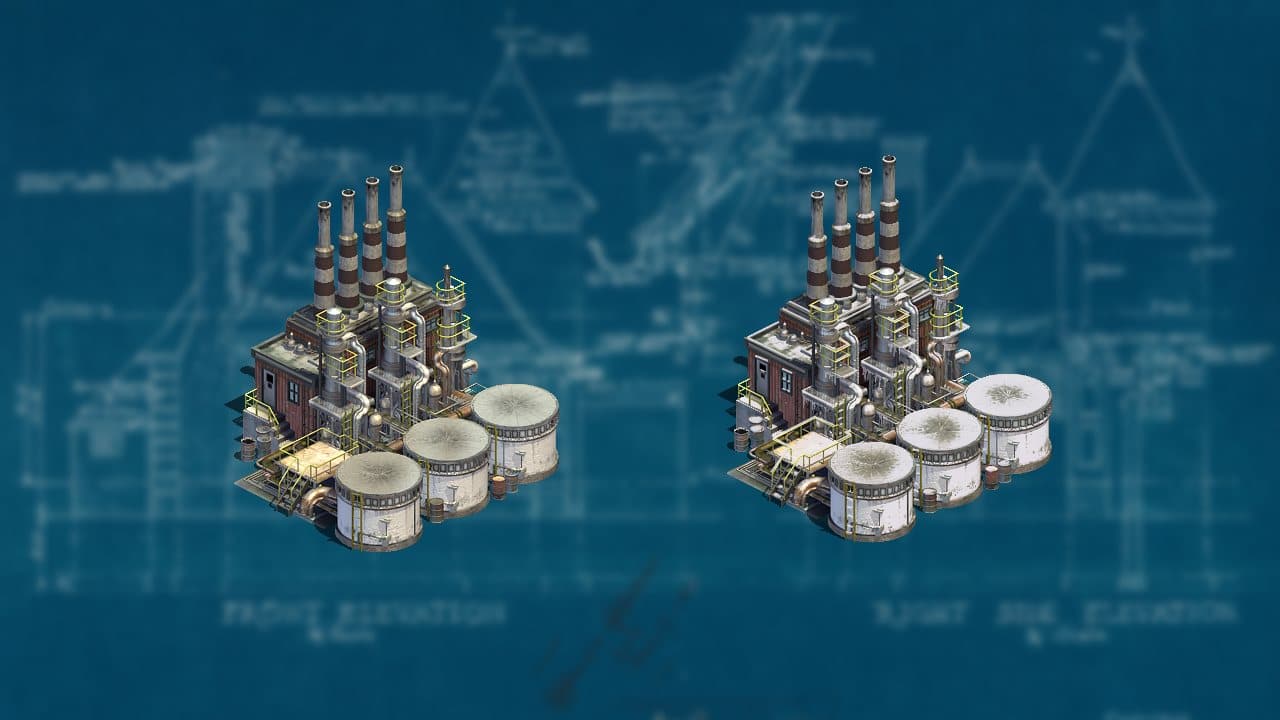
Temple
The wheels are gone, so I guess we’re using a sled now. Better pray that it works.7
By default (with no research), a Temple will slightly increase the national borders, hit points, and attack range of the City that it’s built next to. Like all structures in this list, you can only build one within each City’s economic radius and a Temple will only provide its local benefits to one City even if within the economic radius of more than one City.
To build a Temple you need to have researched Science 1 (which is an amusing juxtaposition). You’ll also need 80 Timber to get your first one built, and there’s ramping cost of 30 Timber for each Temple after that (the same base and ramping costs as a Market). Upon completion, the Temple provides a completion bonus of 30 Wealth (also like a Market).
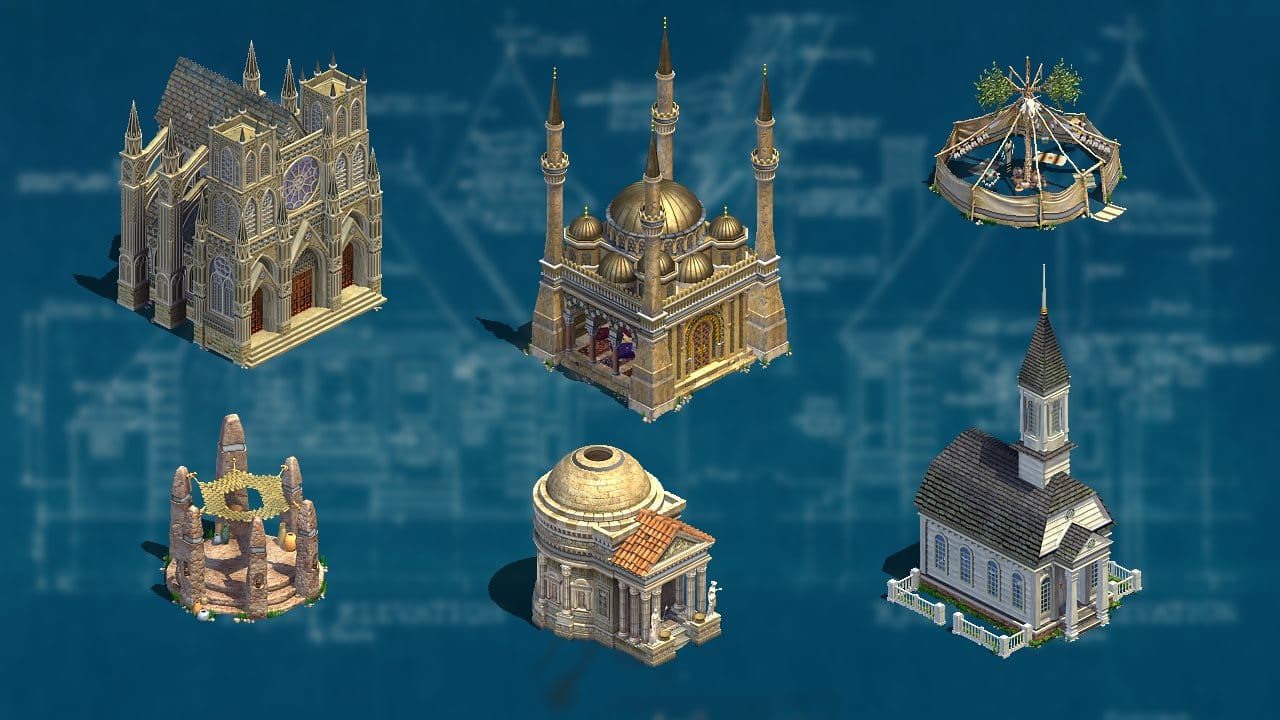
The sled Temple does at least follow the previously established pattern of having two lines of technology to research, with the first improving its default effect and the second being a different, unrelated effect.
- Religion increases the effect that Temples have on the national borders, attack range, and hit points of Cities.
- Taxation‘s effects have previously been covered in Part 1 and Part 3 of this article series, but will be included here for the sake of completeness anyway. It passively provides Wealth generation based on the amount of territory you own (more territory, more Wealth). It also increases the gather rate of Merchants on rare resources, including the non-Food aspects of Fish.8
| Religion Technology | Cost | Requires | Effects |
|---|---|---|---|
| None | - | - | City border push +2 City attack range +1 City HP +25%* |
| Religion | 70 Food, 70 Wealth | Civic 2 | City border push +3 City attack range +2 City HP +50%* |
| Monotheism | 150 Food, 150 Wealth | Civic 4 | City border push +6 City attack range +3 City HP +100%* |
| Existentialism | 360 Food, 360 Wealth | Civic 6 | City border push +9 City attack range +4 City HP +150%* |
| Taxation Technology | Cost | Requires | Effects |
|---|---|---|---|
| None | - | - | No Wealth income; no bonus to rare resource gather rate. |
| Taxation | 80 Food, 80 Timber | Civic 1 | 50% taxation rate** Gather rate of rare resources +20% |
| Monotheism | 160 Food, 160 Timber | Civic 3 | 100% taxation rate** Gather rate of rare resources +50% |
| Social Contract | 320 Food, 320 Timber | Civic 5 | 200% taxation rate** Gather rate of rare resources +100% |
| Income Tax | 480 Food, 480 Timber | Civic 6 | 300% taxation rate** Gather rate of rare resources +200% |
* This effect stacks multiplicatively (not additively) with the Lumber Mill’s B-Tech which increases the HP of all structures. I.e. a 2500 HP Large City can get +100% (Monotheism from Temple) and +20% (Architecture from Lumber Mill) and end up at 6000 HP (2500 * 2 * 1.2) instead of 5500 HP (2500 * 2.2).
** Taxation rate provides wealth equal to the rate times the percentage of the map which is your territory. E.g. 50% taxation when you control 24% of the territory of the map would provide +12 Wealth income. This only works for your own territory (not allied) and does not scale with player count or map size, meaning large maps with lots of players will actually stunt everyone’s Taxation income.
If a Temple is destroyed, its effects on a City will be lost. This means that once the second level of Religion is researched, it’s usually faster to first destroy the Temple and then focus on the City afterwards rather than attack the City directly from the onset. Consequently, it’s usually best to place your Temple on the “safe” side of a City where it will be difficult for your opponent to destroy if your City is sieged. This also applies to other structures which you especially want to keep alive (such as military buildings and Wonders).
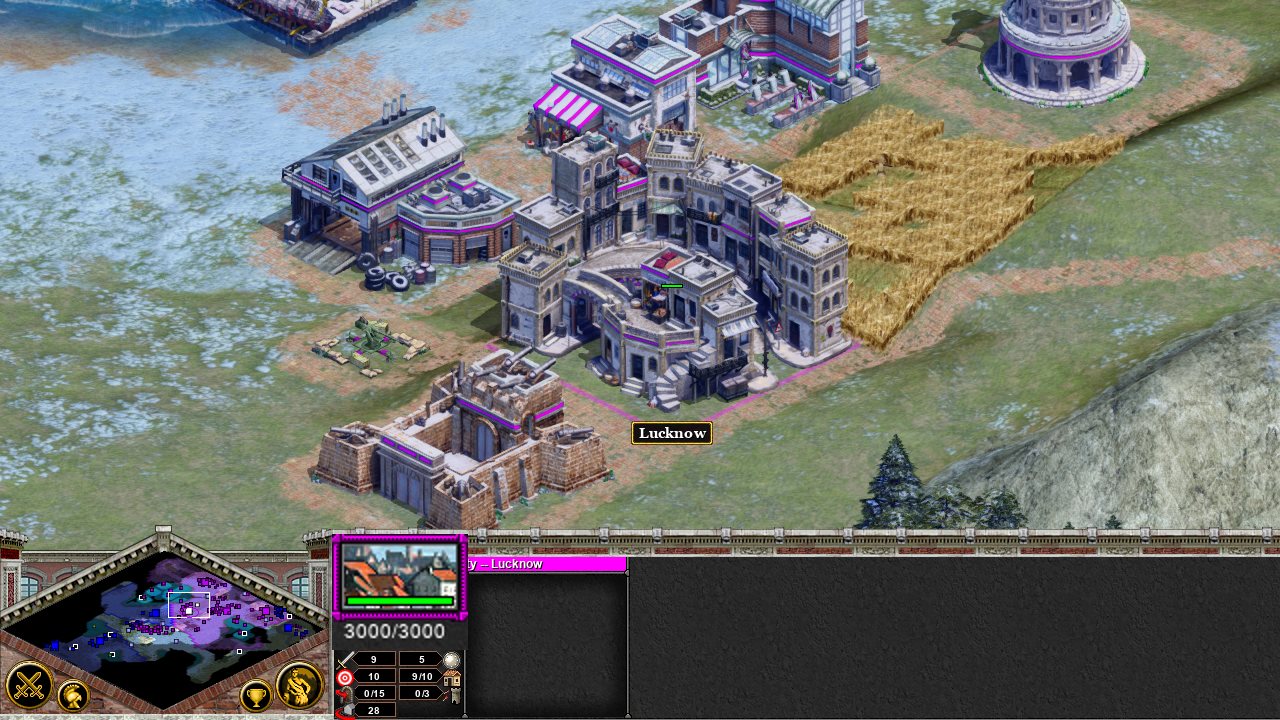
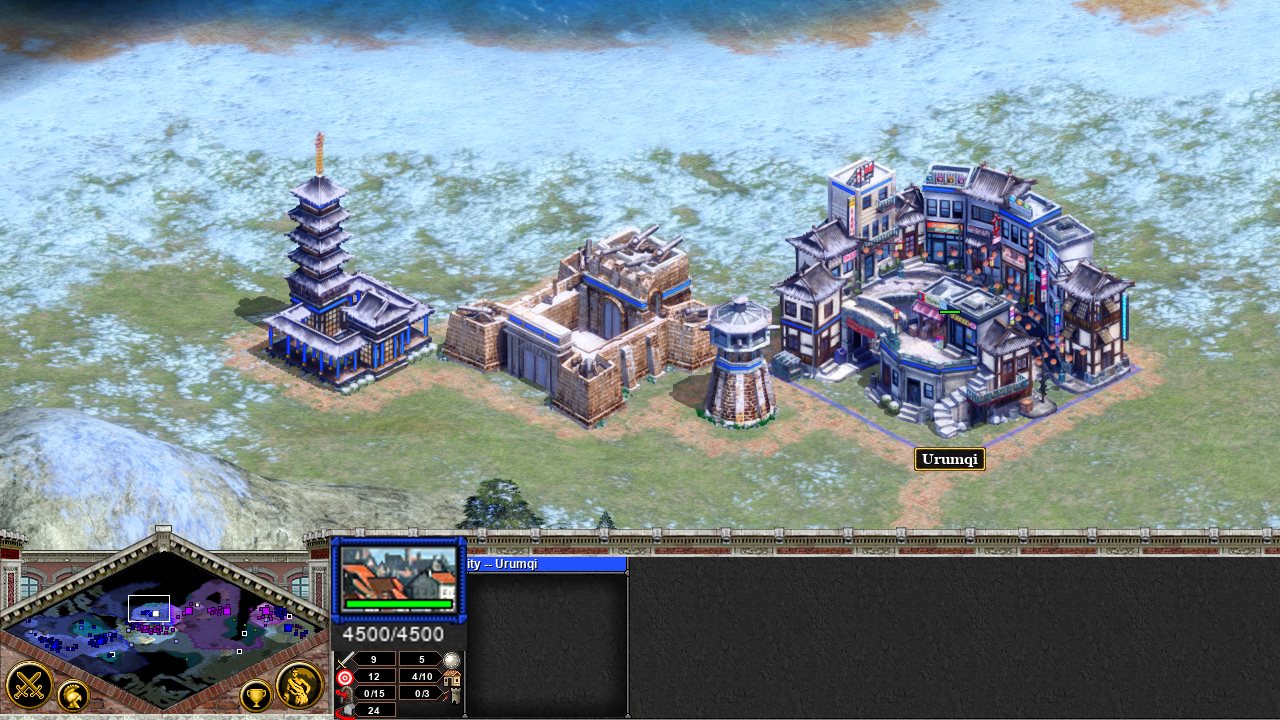
University
Armed with the power of smart, the Magician-Scholars take your sled and turn it into a hoverboard – who needs to touch the ground anyway?
Universities are super weird, because they are both the basic structure for their resource (Knowledge), but also the enhancement structure for it (and therefore themselves).
Per usual a University must be built inside a City’s economic radius, and you can only build one per City.
Building a University requires Classical Age (II). It costs 60 Timber and 30 Wealth, with an additional ramping cost of 20 Timber and 20 Wealth. You get 25 Knowledge as a completion bonus.

Each University starts off with no Scholars inside, but generates a flat +10 Knowledge income independent of the number of Scholars occupied inside (including no Scholars). Each Scholar (costing 30 Wealth with a ramping cost of 2 Wealth) produces +5 Knowledge. Because Scholars start off quite inefficient compared to actual Universities themselves, during the early game it’s usually better to build multiple empty Universities instead of training Scholars.
The single line of University research has no name, so I’m going to take the liberty of dubbing it Academia. It increases the amount of Knowledge produced by Scholars while they’re garrisoned in a University.9
| Academia Technology | Cost | Requires | Effects |
|---|---|---|---|
| None | - | - | Scholars generate +5 Knowledge each while occupied inside a University. |
| Literacy | 200 Timber | Medieval Age (III), Science 3 | Scholars generate +7 Knowledge each while occupied inside a University. |
| Printing Press | 400 Timber | Gunpowder Age (IV), Science 4 | Scholars generate +10 Knowledge each while occupied inside a University. |
| Scientific Method | 600 Timber | Enlightenment Age (V), Science 5 | Scholars generate +15 Knowledge each while occupied inside a University. |
| Institutional Research | 900 Timber | Industrial Age (VI), Science 6 | Scholars generate +20 Knowledge each while occupied inside a University. |
| Supercomputers | 1200 Timber | Modern Age (VII), Science 7 | Scholars generate +25 Knowledge each while occupied inside a University. |
Note that the Academia upgrades do not affect the base +10 Knowledge generation of a University – only its Scholars. This means that the maximum output of a single University is as follows:
| Academia Technology | Per-Scholar output | University max output |
|---|---|---|
| None | +5 Knowledge | +45 Knowledge |
| Literacy | +7 Knowledge | +59 Knowledge |
| Printing Press | +10 Knowledge | +80 Knowledge |
| Scientific Method | +15 Knowledge | +115 Knowledge |
| Institutional Research | +20 Knowledge | +150 Knowledge |
| Supercomputers | +25 Knowledge | +185 Knowledge |
This does a good job of demonstrating how the first Academia upgrade is somehow both powerful and weak at the same time. Despite the fact that it’s a 40% (!) increase in Scholar-only Knowledge output, having 5 buffed Scholars would still produce the same amount of Knowledge as having 5 unbuffed Scholars and an additional empty University.
Closing Words
I’m glad this article was eventually completed without resorting to literally just copy pasting the wiki pages or simply linking to them. I started writing it in late 2018 and really struggled to find a way of presenting all the information that didn’t feel to me like a waste of the reader’s time.
Anyway, this is all of the (what I consider) mostly boring stuff out of the way. In Part 5 — which should be the final part in this particular series — I’ll delve into detailed comparisons of basic production buildings vs their enhancement buildings. When is it better to build a Farm vs a Granary? What about with Mines and Smelters? And so on.
After the Economy series is done, I’ll be finishing it up with a postscript of sorts – an article talking about the balance between economy and military within Rise of Nations. That as-of-yet unwritten article is actually why I started the Economy series in the first place, so that all the necessary economic concepts would be covered (and can be linked to as needed) before moving onto talking about the balancing act of using them. Hope to catch you in the next articles. 👋
Other articles in this series:
- Part 1: Basic Resources
- Part 2: General Concepts
- Part 3: Fish and Rare Resources
- Supplementary: Demystifying Caravans
- About a year ago, whoops.
- The game manual calls these “enhancement” buildings. I personally prefer “amplifier” since it more accurately conveys their core purpose (amplifying resource production), but I suppose when you factor in their secondary upgrades maybe “enhancement” does cover their entire role more appropriately.
- Interesting but generally not useful side note: Agronomics research at the Granary applies permanently to Fishermen. Even if all your Granaries are destroyed, they’ll still receive the listed bonus. Farms still need their own nearby Granary to be there though.
- Frustratingly, even with max tooltip info, the exact stats of Supply Wagons isn’t stated in the game for some reason. I used single-unit units (i.e. no triplets like hoplites and such) with various movement speeds and told the unit and a supply wagon (separately selected) to move to the same point on the other side of a custom scenario map with no terrain blocking the path of either unit. Based on my testing, Forage made the SW move at >30 but <32; Supply made the SW move at >36 but <39 (and it appeared to match the 37 of a Commando); and Logistics made the SW move at >42, but only by a tiny amount (which makes 43, and therefore +6 per rank, very plausible). For reference, a SW with no tech has 25 movement speed.
- An anonymous wiki user with IP address 112.134.102.97, who added this information to the RoN wiki in late March 2019.
- Note how this is one Science tech higher than the age, since Classical Age (II) actually aligns with Science 1 in the Library.
- ::fingerguns::
- The Food is increased via the Granary B-Tech, as previously covered.
- Scholars that aren’t garrisoned in a University don’t produce any Knowledge, with or without upgrades.
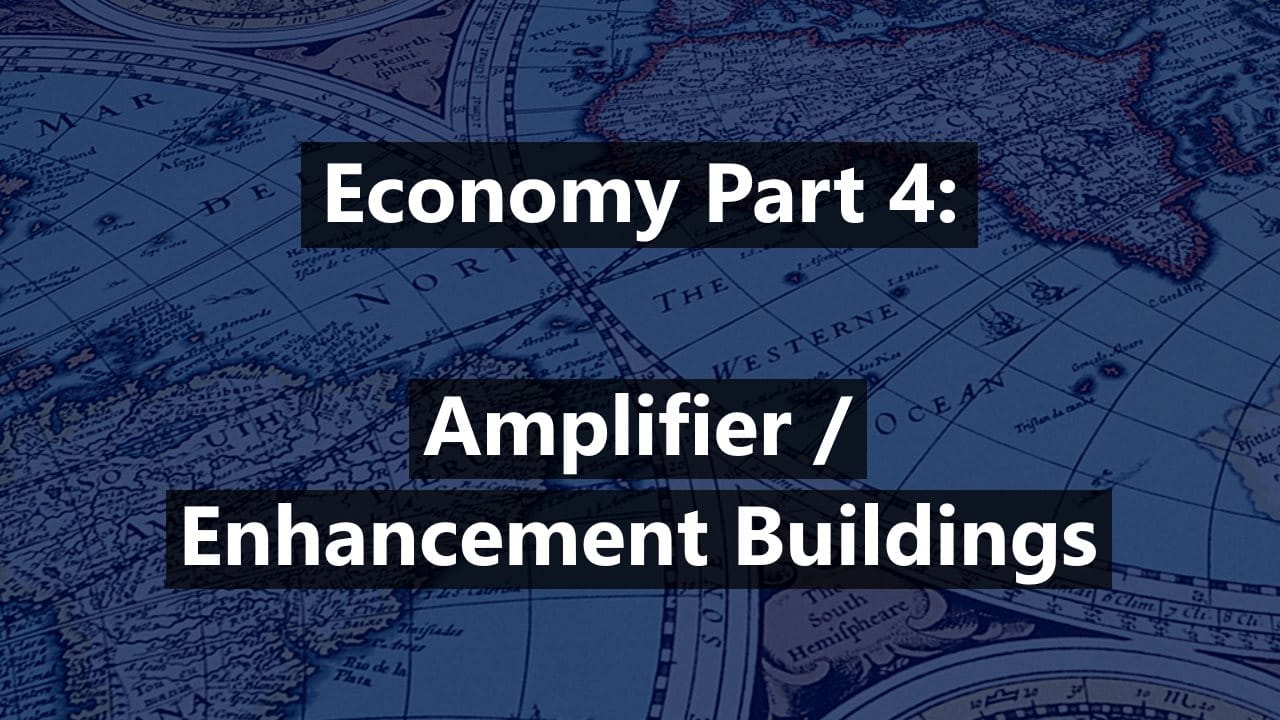
Loved reading this whole economy series, really well presented and entertaining. I hope you are still planning on finishing it and writing the follow up about the balance between economy and military 😊
It’s on the to-do list, but it’s a VERY long list of things to get through >< I still 100% want to get that article out since I think it's a very valuable one (so much so that it was the reason I wrote the whole economy 101 series) - it just might take a while to get to!